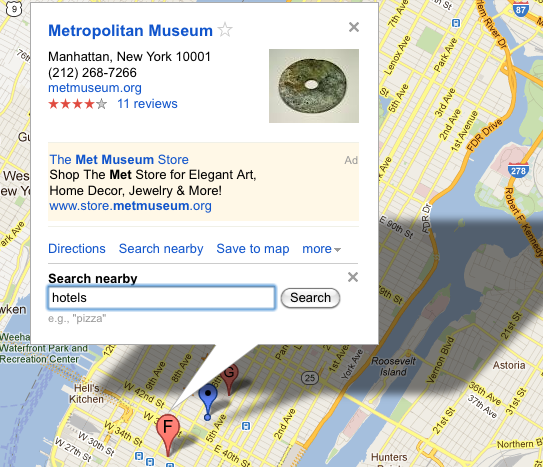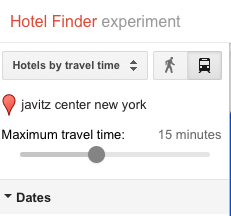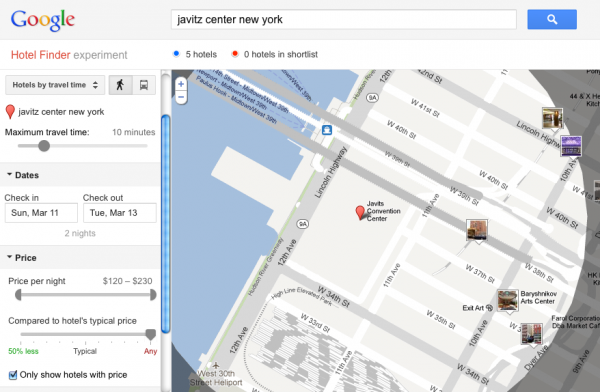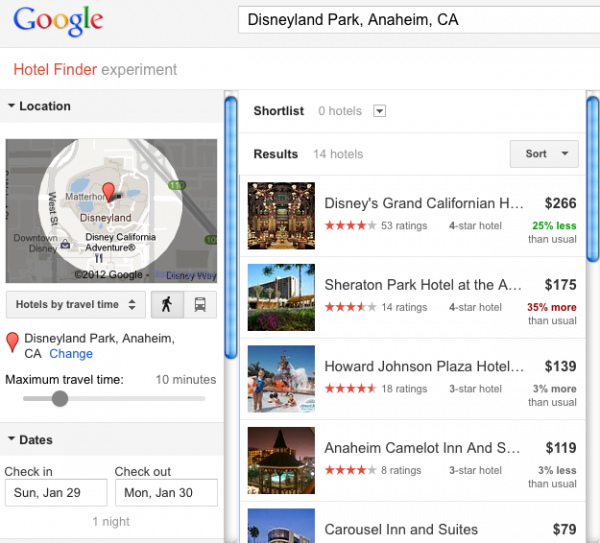Google’s “Find Hotels By Travel Time” Offers Some Of That “Innovation” Google Was Talking About
Before Google was formally approved to buy travel software company ITA, the company argued that the acquisition would result in “innovation” for travelers and travel search users. Beyond the appearance of flight times/routes in search results we haven’t seen much “innovation” yet. Google’s new “find hotels by travel time” experiment is, however, an example of […]
Before Google was formally approved to buy travel software company ITA, the company argued that the acquisition would result in “innovation” for travelers and travel search users. Beyond the appearance of flight times/routes in search results we haven’t seen much “innovation” yet. Google’s new “find hotels by travel time” experiment is, however, an example of how Google might deliver new functionality and shake things up in the intensely competitive yet paradoxically complacent travel segment.
There are travel verticals that will allow users to look for hotels near landmarks or filter by distance from the “city center” (or centroid). And almost all of the popular travel search engines allow you to see the hotel location on a map. Google Maps itself will allow you to find a point or destination and then “search nearby” for hotels.
Yet Google’s “Hotel Finder‘s” new ability to filter hotels by travel time (by transportation method) is unique and quite useful. Although Hotel Finder is generally available for a broad array of destinations, Google says that transit time search “is only available in cities where we have partnered with local transit agencies to integrate their data into Google Maps.”
Here’s a practical use case: if you were coming to an SMX event in New York, for example, and wanted to be within reasonable walking distance from the glorious Jacob Javitz center where the conference is held you could use the tool.
Another example would be a family traveling to Southern California to Disneyland. You want to be within close walking distance of the “Magic Kingdom” but not pay the exorbitant prices of the hotels “inside the park.” It works nicely in that situation. Indeed, one can quickly conjure up numerous such scenarios and examples.
How is any of this all that different from “search nearby” or “distance from” filters? This difference is subtle but meaningful. Hotel Finder also allows you to simultaneously filter by price, ratings and reviews and hotel class.
What I don’t really like about Hotel Finder is the clunky the three-panel interface. But I’m sure that will improve over time.
In some respects Hotel Finder provides greater travel-search flexibility and options than more established travel sites. You can search for a specific attraction or destination without first specifying a city; for example: Disneyland, rather than starting with “Anaheim, CA” and then locating Disneyland, and so on.
As Google rolls out new features hopefully others will feel compelled to match them — and we’ll see an upgrade across the spectrum. If so Google will have done its job and made the market more competitive and user-friendly.
I’m also eager to see how Google will translate all this to mobile devices.
Contributing authors are invited to create content for Search Engine Land and are chosen for their expertise and contribution to the search community. Our contributors work under the oversight of the editorial staff and contributions are checked for quality and relevance to our readers. Search Engine Land is owned by Semrush. Contributor was not asked to make any direct or indirect mentions of Semrush. The opinions they express are their own.






